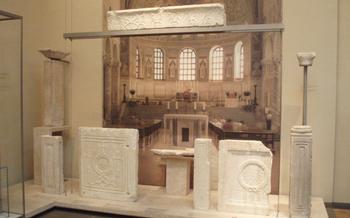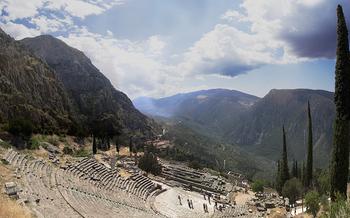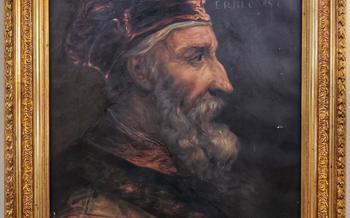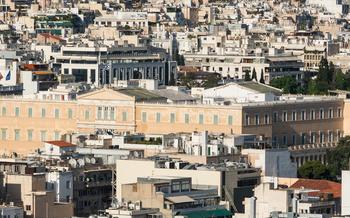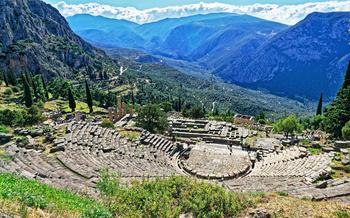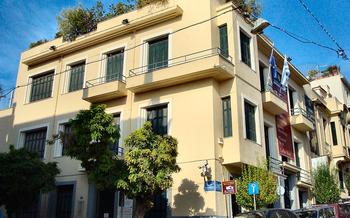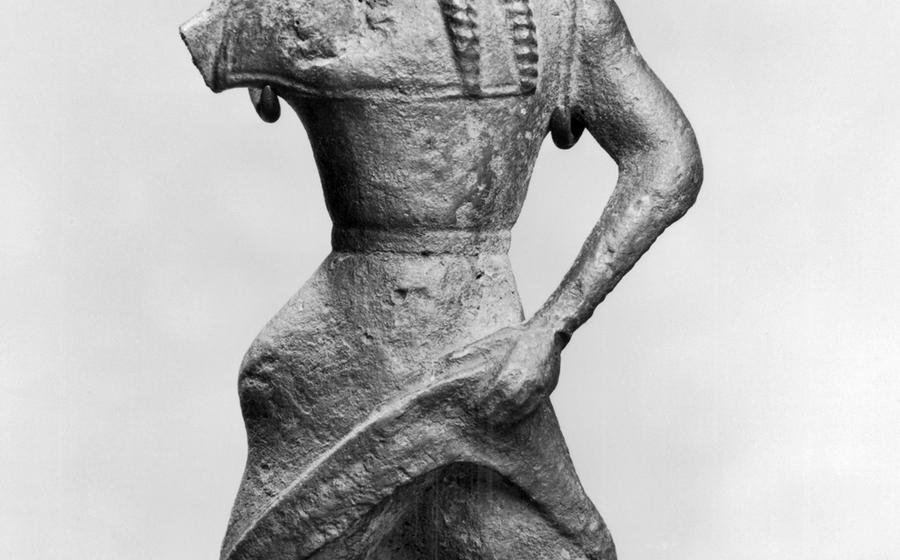
Museum of the History of the Greek Costume
- A Stroll in Time
- Location and Accessibility:
- Stepping Through the Doors
- Costumes of the Gods
- Everyday Attire of Ancient Greeks
- Footwear and Accessories
- Byzantine Splendor
- The Age of Enlightenment
- Traditional Greek Costumes: A Tapestry of Regional Identities
- Contemporary Fashion Influences
- Educational Programs and Workshops
- Shopping for Souvenirs
- Combine History with Art
- Capture the Moment
- Insider Tip:
A Stroll in Time
Step into the fascinating world of ancient Greek attire at the Museum of the History of the Greek Costume. This hidden gem in Athens takes you on a captivating journey through time, showcasing a unique collection of costumes that tell the story of Greek fashion and textiles from antiquity to modern times. Discover the symbolism and cultural significance of traditional attire, and witness the evolution of Greek style as it intertwined with history, mythology, and everyday life.
Location and Accessibility:
The Museum of the History of the Greek Costume is conveniently located at 22 Vasilissis Sofias Avenue in the heart of Athens, Greece. It is situated within walking distance of several other cultural attractions, including the Benaki Museum and the Byzantine and Christian Museum. The museum is easily accessible by public transportation, with the nearest metro station being Evangelismos. For those who prefer a guided experience, several tour operators offer visits to the museum as part of their Athens sightseeing itineraries. The museum's hours of operation are from Tuesday to Sunday, 9:00 AM to 3:00 PM, with an admission fee of €5 for adults and €3 for students and seniors.
Stepping Through the Doors
Stepping into the Museum of the History of the Greek Costume is like embarking on a journey through time. The ambiance is warm and inviting, with soft lighting illuminating the intricate displays. Welcoming staff are ready to greet visitors and provide informative brochures that guide you through the exhibits.
The layout of the museum is well-organized, with each section dedicated to a different era or aspect of Greek costume history. Interactive displays and multimedia presentations bring the costumes to life, providing insights into their cultural significance and symbolism. Visitors can see how fashion and textiles evolved over the centuries, from the simple tunics of ancient times to the elaborate embroidered garments of the Byzantine Empire.
Costumes of the Gods
Among the museum's most captivating exhibits are the exquisite replicas of ancient Greek theatrical costumes. These elaborate creations transport visitors back to a time when gods and heroes graced the stages of ancient Greek theaters. The vibrant colors and intricate designs of these costumes are a testament to the artistry and craftsmanship of ancient Greek artisans.
Each costume holds a deep symbolic meaning, representing the character it portrays and the mythology surrounding it. From the flowing robes of Zeus, the king of the gods, to the fierce armor of Athena, the goddess of war, every detail is carefully considered to convey the essence of the deity. These costumes were not merely garments; they were an integral part of the performance, helping to bring the myths to life and immerse the audience in the world of the gods.
Everyday Attire of Ancient Greeks
In the realm of ancient Greek attire, tunics, chitons, and himations reigned supreme. These garments, as simple as they may seem, held significant cultural and symbolic meanings.
The chiton, a rectangular piece of fabric, was the most versatile garment, worn by both men and women. It could be draped, pinned, or belted, creating different styles for various occasions.
The peplos, a version of the chiton, was specifically worn by women. It featured a large rectangular piece of fabric folded over at the top and fastened at the shoulders, creating a distinctive silhouette.
The himation, a large rectangular or square cloth, served as an outer garment, draped over the chiton or peplos. It was particularly popular among men, adding a touch of elegance and formality to their attire.
Materials and Colors:
The ancient Greeks employed a variety of natural materials for their clothing, primarily wool, linen, and cotton. Wool, obtained from sheep, goats, or camels, was commonly used during colder months, providing warmth and durability. Linen, derived from flax plants, offered a lightweight and breathable option for warmer climates. Cotton, though less prevalent, was also utilized.
Color played a significant role in ancient Greek fashion. White, the most common color, symbolized purity and simplicity. Bright colors like red, blue, and yellow were reserved for special occasions or to denote social status.
Social and Occupational Distinctions:
Clothing choices in ancient Greece reflected social class and occupation. Citizens of higher social standing often wore finer materials, such as imported silks and dyed fabrics. Elaborate embroidery and ornamentation further distinguished their attire.
Artisans and workers, on the other hand, wore simpler garments made from sturdy materials like wool or linen. Their clothing often reflected the nature of their work, with specific styles or colors associated with particular occupations.
Evolution of Fashion:
From the Minoan to the Hellenistic periods, ancient Greek fashion underwent significant transformations. The Minoans favored elaborate, colorful garments, often adorned with intricate designs and patterns. In contrast, the classical period witnessed a shift towards simpler, more draped styles, emphasizing the natural form of the body.
The Hellenistic period saw the influence of foreign cultures, resulting in a fusion of styles and the incorporation of new materials and techniques. This era marked the emergence of more elaborate and ornate costumes, particularly for theatrical performances and religious ceremonies.
Footwear and Accessories
Sandals and boots were the primary footwear of ancient Greeks, with styles varying depending on social status and occupation. Simple leather sandals were worn by the working class, while intricate designs with colorful straps adorned the feet of wealthy citizens. Boots, often made of leather or felt, provided protection during travel or military campaigns.
Jewelry, belts, and hair ornaments were essential accessories, showcasing personal style and cultural significance. Greeks adorned themselves with necklaces, earrings, bracelets, and rings, often made of gold, silver, or bronze. Belts served both functional and decorative purposes, with intricate buckles and embellishments. Hair ornaments, such as pins, combs, and wreaths, added a touch of elegance to both men's and women's hairstyles.
Jewelry held particular importance in Greek culture and mythology. Gods and goddesses were often depicted wearing specific jewelry pieces that symbolized their attributes or powers. Motifs such as the thunderbolt of Zeus, the owl of Athena, or the caduceus of Hermes carried symbolic meanings that resonated with the ancient Greeks.
Byzantine Splendor
As the Roman Empire transitioned into the Byzantine Empire, so too did the costumes of its people. Christianity, now the dominant religion, left an indelible mark on fashion and textiles. Elaborate embroidery adorned garments, and rich fabrics such as silk and velvet became commonplace. The costumes of emperors, empresses, and religious figures were particularly opulent, showcasing the wealth and power of the Byzantine court.
Byzantine costumes were often adorned with religious symbols, such as the cross or the image of the Virgin Mary. Jewelry also played a significant role, with intricate pieces crafted from gold, silver, and precious stones. Necklaces, earrings, bracelets, and rings were common accessories, often featuring symbolic motifs and designs.
The Age of Enlightenment
During the Greek Enlightenment, which spanned the 18th and early 19th centuries, fashion trends underwent a significant transformation. The influence of Western Europe, particularly France, became increasingly prominent, leading to a gradual departure from traditional Greek styles. New materials and techniques were introduced, such as fine fabrics, lace, and embroidery, adding a touch of elegance and sophistication to Greek attire. Clothing became more tailored and fitted, reflecting the prevailing aesthetic sensibilities of the period.
Prominent figures of the Greek Enlightenment, such as Adamantios Korais and Rigas Feraios, embraced these new fashion trends, using clothing as a means of expressing their progressive ideas and aligning themselves with the broader European intellectual movement. Their attire reflected a fusion of traditional Greek elements with Western influences, embodying the spirit of cultural exchange and modernization that characterized this era.
Traditional Greek Costumes: A Tapestry of Regional Identities
The Museum of the History of the Greek Costume not only showcases ancient attire but also delves into the rich tapestry of traditional Greek costumes. These costumes, varying from region to region, reflect the diverse cultural heritage of the country.
In the museum's exhibits, visitors can admire stunning examples of traditional costumes from different parts of Greece, each with its own unique characteristics. From the intricate embroidery of the Cretan costumes to the vibrant colors of the Peloponnesian attire, each piece tells a story of regional identity and pride.
Traditional Greek costumes were not merely garments; they were symbols of cultural continuity, expressing the values, beliefs, and traditions of each community. Worn during festivals, celebrations, and everyday life, these costumes played a vital role in shaping the collective identity of the Greek people.
The museum's collection includes costumes from all corners of Greece, allowing visitors to trace the evolution of fashion and style across the centuries. Whether it's the stately fustanella of the Evzones or the graceful island dresses of the Aegean, each costume represents a piece of the Greek cultural puzzle.
By showcasing these traditional costumes, the Museum of the History of the Greek Costume pays homage to the diverse cultural heritage of Greece and celebrates the enduring spirit of its people.
Contemporary Fashion Influences
Contemporary Greek fashion designers are increasingly drawing inspiration from the rich history of Greek costume. They fuse traditional elements with modern silhouettes and fabrics, creating unique and stylish pieces that resonate with a global audience. Designers like Mary Katrantzou, Vrettos Vrettakos, and Celia Kritharioti are gaining international recognition for their innovative designs that celebrate Greek heritage. Their collections often feature intricate embroidery, vibrant colors, and flowing silhouettes reminiscent of ancient Greek garments. By showcasing traditional motifs and techniques in a contemporary context, these designers are helping to preserve and promote Greek cultural heritage while pushing the boundaries of fashion.
Educational Programs and Workshops
The Museum of the History of the Greek Costume is not just a passive display of artifacts; it is also an active center for learning and engagement. The museum organizes a variety of educational programs and workshops to promote a deeper understanding of costume making, design, and the cultural significance of attire.
These programs are designed for visitors of all ages, from school children to adults, and offer hands-on experiences that bring the history of Greek costumes to life. Participants can learn about the techniques and materials used in traditional costume making, try their hand at designing their own garments, and even create replicas of ancient Greek costumes.
Through these workshops, the museum not only preserves and showcases Greek cultural heritage but also actively engages visitors in the creative process, fostering a sense of appreciation for the artistry and craftsmanship that went into the making of these historical garments.
Shopping for Souvenirs
The Museum of the History of the Greek Costume also offers a unique opportunity to shop for souvenirs that are both meaningful and memorable. The museum shop is stocked with a variety of items inspired by the exhibits, allowing visitors to take a piece of Greek history home with them.
Replica costumes, jewelry, and other items are available for purchase, providing visitors with the chance to own a piece of ancient Greek fashion or traditional Greek attire. Books and publications on Greek costume history are also available, offering visitors the chance to delve deeper into the subject and learn more about the significance of costume in Greek culture.
By purchasing souvenirs from the museum shop, visitors not only support the museum and its mission to preserve and promote Greek cultural heritage but also create lasting memories of their visit to this unique and fascinating institution.
Combine History with Art
The Museum of the History of the Greek Costume is a treasure trove of cultural heritage, but it is not the only one in Athens. The city is home to a wealth of museums and archaeological sites that offer a comprehensive journey through Greek history and art.
Start with the Acropolis Museum, a modern architectural marvel that houses the priceless artifacts from the ancient citadel of the Acropolis. Admire the Parthenon sculptures, marvel at the Caryatid maidens, and learn about the religious and political significance of this sacred hill.
Next, head to the National Archaeological Museum, one of the largest and most comprehensive archaeological museums in the world. Explore its vast collection of ancient Greek sculptures, pottery, jewelry, and other artifacts that span from the Neolithic period to the Roman Empire.
Finally, don't miss the Benaki Museum, which houses a diverse collection of Greek art and artifacts from prehistoric times to the present day. Admire Byzantine icons, Ottoman-era textiles, and modern Greek paintings, all under one roof.
By combining your visit to the Museum of the History of the Greek Costume with these other cultural attractions, you can create a comprehensive itinerary that will immerse you in the rich history and artistic heritage of Athens.
Capture the Moment
The Museum of the History of the Greek Costume encourages visitors to capture the beauty and significance of the exhibits through photography. Most areas of the museum are photography-friendly, allowing you to document your journey through the history of Greek costume. Share your memories online, using respectful photography etiquette and avoiding flash. Your photographs will serve as lasting mementos of your visit, reminding you of the exquisite craftsmanship and cultural heritage you witnessed. Embrace the opportunity to document your unique experience at this remarkable museum.
Insider Tip:
To fully immerse yourself in the world of Greek costume, plan your visit to the museum during the off-season when crowds are smaller, allowing you to savor the exhibits at a leisurely pace. Take advantage of guided tours to gain in-depth insights and fascinating anecdotes from knowledgeable guides. Before your visit, explore the museum's website to stay updated on special events, workshops, and temporary exhibitions that might align with your interests. This insider tip will help you make the most of your time at the Museum of the History of the Greek Costume, ensuring a truly enriching and memorable experience.

